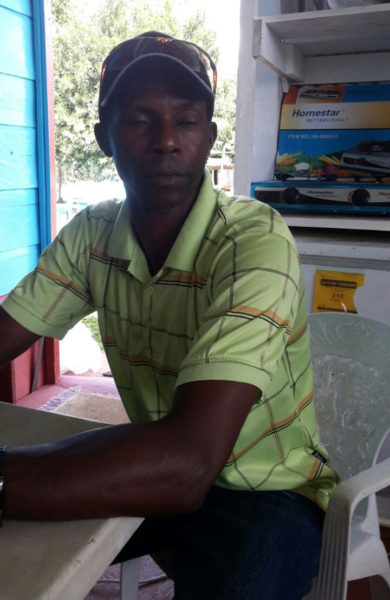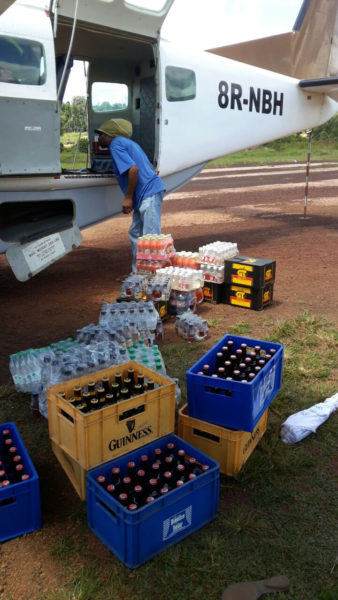You could be forgiven for thinking that Rudolph Wellington is a native of Kamarang. He appears settled there with his family and his store. He has been settled there since 1989 having relocated from Annandale on the Essequibo Coast in search of a better life.
Prior to taking up residence at Kamarang, Wellington used to visit, working as a carpenter on contract. He had also tried his hand at small-scale mining as well as providing some mining supplies. Eventually, he leased a piece of land and built a shop and stayed.
The ‘better life’ that he came to Kamarang for is one of peaks and troughs. The gold mining industry has that kind of effect on businesses that serve the sector and there is no apparent reason why it should have made an exception for the intrepid Essequibian.

Located in the Cuyuni/Mazaruni area of administrative Region Seven, Kamarang has long been known as a community where the interests of miners and farmers converge. The 600-odd residents, Amerindians and coastlanders, who reside there have grown accustomed to what the community offers. There is evidence of struggle associated with the challenges facing a long-neglected, long-underdeveloped community. These days, you can see a measure of evidence of the transformation the gold can bring, though on the whole the underpinning poverty remains evident. Once you contemplate a community like Kamarang carefully you get to thinking that gold mining will only make sense to the communities where the gold is located when the gold begins to bring far more generous measures of social change and a more permanent development to those communities. That is not the case at this time.
Kamarang has turned Wellington into a tough-as-nails trader. The impact of falling gold prices has hit the mining sector hard and Kamarang is one of those communities that comes down with influenza whenever mining sneezes.
Amerita Thomas possesses as reliable a perspective as any on life in Kamarang. She used to be the vice-chairman of the Upper Mazaruni District in Region Seven. These days she is employed as a Social Worker and has become familiar with the social issues like child abuse and teenage pregnancy. Thomas provides such support as she can. Since February she has been working with parents and providing counselling. In a community far away from the support systems more readily available in coastal areas, it is a mountain to climb.
Here again, the impact of gold rears its head. You see evidence of a kind of ‘easy come, easy go’ lifestyle. Night life at Kamarang manifests itself mostly in entertainment, pockets of loud music and drinking. Night life means that gold frequently changes hands for goods and services. There is an official curfew here. The lack of effective enforcement is patently obvious.
In other respects, too, Kamarang is vulnerable. Mining is polluting the river and the residents who depend on the river for water and for fish worry.

Wellington says that up to about three years ago miners operated about 27 dredges in the Kamarang area. These days there are about six left. Those operations that have disappeared have been victims of falling gold prices. The dredges are being rested and some of the small and medium-scale operators have gone back to farming.
Gold mining has become the unquestionable arbiter of life in many interior communities. It is the fortunes of the sector that sets prices, regulates employment levels, fashions lifestyles and ‘calls the shots’ as far as the profitability of virtually any other type of business is concerned.
Wellington’s store, like others in the mining communities, has the character of an old-fashioned trading post. If you are trading in a mining community it makes sense to stock every conceivable thing needed by the miners and the community at large, or at least you try.

Wellington’s store, one of about six enterprises strategically located close to the airstrip supplies the miners with some of the more modest equipment needs as well as food and some clothing. The trading establishments along with the hospital, the Amerindian Hostel and the nursery and primary schools comprise what is known as the Kamarang Compound. Their proximity to the airstrip is a function of ease of delivery for goods arriving from the city by aircraft. The nearest village, Waramadong, is situated 45 minutes away by boat.
The businesses are all run by owners with hired help. About a year ago, in the face of the squeeze of trading Wellington had to let five workers go.
Activity at the airstrip provides an indication of the prevailing level of commercial activity. Wellington says that in better times you could find 10 or 12 aircraft at Kamarang, shuttling fuel and food to Mazaruni communities. Last Thursday seven or eight aircraft came and left.
The Air Services Charter that landed at Kamarang on Saturday generated the customary hive of activity. The helpers at the stores were pressed into service offloading mattresses, rice, soft drinks and a bewildering array of other items. Some of the goods were being taken away to further locations by ATVs and boats.
There are days too when residents—housewives, farmers and miners—from various other Mazaruni villages travel to Kamarang to trade farm produce and gold for supplies. These days residents of Paruima and Arrau come too. Both villages are close to the border with Venezuela and time was when logistics dictated that they trade with Venezuela. Economic circumstances in Venezuela now dictate that they travel to Kamarang to get their supplies.
Wellington says that residents travelling from Paruima to Kamarang must negotiate a waterfall. They do so by leaving their boats on the Paruima side of the Kamarang River and using a strip of land close to get to Kamarang. The entire journey takes about eight hours.
At Kamarang, fuel prices are as good a barometer of the cost of living as anything. Up to last week fuel was being purchased at $2,000 per gallon. Quite a few owners cannot afford to run their dredges at those prices. A 1.5 litre bottle of drinking water can cost you $1,000 and you can pay half that amount for a can of Fruta juice. It figures. Air freight to Kamarang from the city costs $125 per pound.




